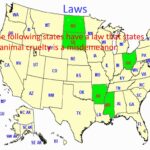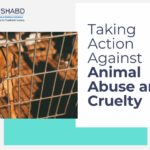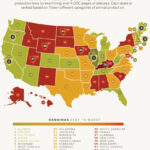Animal cruelty is an egregious violation of ethical consideration, encompassing a broad spectrum of behaviors that inflict suffering upon non-human creatures. In the United States, certain acts of animal cruelty are classified as federal offenses, reflecting societal acknowledgment of the need to safeguard animals from inhumane treatment. This article endeavors to elucidate the types of animal cruelty considered federal offenses, addressing both the evident and obscured elements of this crucial issue.
To fully grasp the gravity of federal animal cruelty offenses, one must first comprehend what constitutes animal cruelty itself. The term broadly refers to any act causing unnecessary pain, suffering, or death to animals. This can include neglect, intentional harm, or exploitation. Federal laws delineate certain types of animal cruelty that reach a level of severity warranting national attention and, consequently, legal intervention.
One of the foremost pieces of legislation in this area is the Animal Welfare Act (AWA), first enacted in 1966 and subsequently amended to enhance its protective measures. The AWA regulates the treatment of animals in research, exhibition, transport, and by dealers. While the Act does not encompass every form of animal cruelty, it addresses specific instances, such as the mistreatment of animals in laboratories or the grotesque conditions of animals in commercial breeding operations, commonly referred to as puppy mills.
In addition to the AWA, the federal government also takes a strong stance against certain egregious behaviors classified under the Pet Protection Act. This legislation particularly penalizes violations involving animal fighting and is pivotal in the fight against blood sports that often contribute to systemic animal cruelty.
Animal fighting, which includes dog fighting and cockfighting, is a particularly heinous form of animal cruelty that is explicitly outlawed by federal law. These organized, often underground events can lead to severe injuries, psychological trauma, and fatalities among animals used for entertainment purposes. Participation in, or promotion of, animal fighting can result in significant penalties, including hefty fines and imprisonment. The motives behind such fights often stem from a disturbing fascination with violence, a reality that calls for deeper societal introspection.
Furthermore, another notable federal offense pertains to the illegal trafficking of wildlife, which falls under the Endangered Species Act (ESA). This Act aims to protect species at risk of extinction due to over-exploitation or habitat loss. Those engaged in poaching or illegal wildlife trade contribute to not only the suffering of individual animals but also to the broader ecological imbalance. The illicit capturing and selling of exotic wildlife for the pet trade or for use in entertainment exacerbates the plight of many species, revealing a disconcerting intersection of capitalism and cruelty.
Federal laws also target the abhorrent practices of hoarding and neglect, which, while sometimes manifesting as unintentional acts, can culminate in severe, systemic suffering for animals. In extreme cases, individuals may accumulate vast numbers of animals without the resources or ability to provide adequate care. The outcome in such scenarios is often devastating. Entrusted with the responsibility for other lives, hoarders often succumb to delusions, spurred by psychological complexities that invite criticism of societal attitudes towards animal ownership and responsibility.
Despite these protective statutes, not all forms of cruelty are addressed at the federal level. State laws vary significantly, resulting in a patchwork of regulations across the country. Certain states have enacted more stringent laws regarding animal cruelty, which may include provisions for punishment related to psychological abuse, abandonment, and neglect. This disparity hints at a broader societal conundrum — a collective fascination with animals juxtaposed against a tangible failure to protect them uniformly.
Moreover, the media plays a pivotal role in shaping public perceptions. Graphic coverage of animal cruelty cases draws attention, igniting outrage and calls for action. However, such reactions can be fleeting. The fascination with animal welfare swells in response to viral cases but often wanes, leaving many issues inadequately addressed. This inconsistency between fleeting outrage and enduring advocacy highlights a deeper cultural ambivalence towards animal rights.
In sum, a variety of animal cruelty offenses warrant federal intervention, encapsulated mainly under the AWA, the Pet Protection Act, and the ESA. While these laws represent vital progress in animal protection, they also expose a myriad of societal tensions regarding the treatment of non-human beings. As our collective consciousness expands, the pursuit of deeper understanding and concrete action remains imperative. Heightened awareness of the types of cruelty condemned by federal law serves not merely to inform but also to galvanize, urging society to reflect on its responsibilities towards all living beings.
Ultimately, it is the moral obligation of humans to advocate for those unable to voice their own suffering. Through comprehensive legislation, community vigilance, and enhanced societal education, the fight against animal cruelty can maintain momentum. With unwavering commitment, we can continue to illuminate the darker corners of this issue, fostering a climate where compassion triumphs over cruelty.







